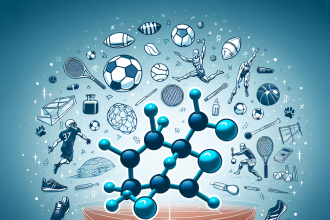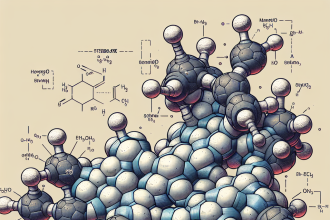-
Table of Contents
The Role of Anastrozole in Hormonal Regulation of Professional Athletes
Professional athletes are constantly pushing their bodies to the limit in order to achieve peak performance. This intense physical activity can have a significant impact on their hormonal balance, leading to potential health risks and performance issues. In recent years, there has been a growing interest in the use of anastrozole, a selective aromatase inhibitor, in the regulation of hormones in professional athletes. This article will explore the pharmacokinetics and pharmacodynamics of anastrozole, its potential benefits and risks, and its role in the hormonal regulation of professional athletes.
The Pharmacokinetics of Anastrozole
Anastrozole is a non-steroidal aromatase inhibitor that works by blocking the conversion of androgens to estrogens. It is primarily used in the treatment of hormone receptor-positive breast cancer in postmenopausal women. However, its use has extended beyond the medical field and into the world of professional sports.
The oral bioavailability of anastrozole is approximately 83%, with peak plasma concentrations reached within 2 hours of ingestion. It is highly protein-bound (over 90%) and is extensively metabolized in the liver. The main metabolite, triazole, has similar pharmacological activity to anastrozole and is excreted primarily in the urine.
The half-life of anastrozole is approximately 50 hours, making it a long-acting drug. This means that it can be taken once a day, making it convenient for athletes who have strict training schedules. However, it also means that it can take several days for the drug to be completely eliminated from the body, which can be a concern for athletes who are subject to drug testing.
The Pharmacodynamics of Anastrozole
The primary mechanism of action of anastrozole is the inhibition of aromatase, an enzyme responsible for the conversion of androgens to estrogens. By blocking this conversion, anastrozole reduces the levels of estrogen in the body, leading to a decrease in estrogen-related side effects such as gynecomastia and water retention.
In addition to its anti-estrogenic effects, anastrozole has also been shown to increase testosterone levels in both men and women. This is due to the feedback mechanism in the body, where a decrease in estrogen levels leads to an increase in the production of testosterone. This increase in testosterone can have a positive impact on athletic performance, as it is a key hormone in muscle growth and strength.
Furthermore, anastrozole has been found to have a positive effect on bone health. Estrogen plays a crucial role in maintaining bone density, and a decrease in estrogen levels can lead to an increased risk of osteoporosis. By reducing estrogen levels, anastrozole can help prevent bone loss and maintain bone health in professional athletes.
The Benefits and Risks of Anastrozole in Professional Athletes
The use of anastrozole in professional athletes has been a topic of controversy, with some arguing that it provides an unfair advantage and others claiming that it is necessary for maintaining hormonal balance in high-performance athletes. However, there is evidence to suggest that anastrozole can provide several benefits for professional athletes.
One of the main benefits of anastrozole is its ability to reduce estrogen-related side effects, such as gynecomastia and water retention. These side effects can be particularly problematic for male athletes, as they can impact their physical appearance and potentially affect their performance. By reducing estrogen levels, anastrozole can help athletes maintain a lean and muscular physique.
Another potential benefit of anastrozole is its ability to increase testosterone levels. As mentioned earlier, testosterone is a key hormone in muscle growth and strength, making it essential for professional athletes. By increasing testosterone levels, anastrozole can potentially enhance athletic performance and aid in muscle recovery.
However, like any medication, anastrozole also carries some risks. The most common side effects reported in clinical trials include hot flashes, joint pain, and fatigue. In rare cases, anastrozole has also been associated with more serious side effects such as bone fractures and cardiovascular events. It is important for athletes to carefully consider these risks before using anastrozole and to consult with a healthcare professional before starting any new medication.
Real-World Examples
The use of anastrozole in professional sports has been a topic of discussion for many years. In 2012, the International Cycling Union (UCI) banned the use of anastrozole in professional cycling, citing concerns about its potential performance-enhancing effects. However, in 2015, the World Anti-Doping Agency (WADA) removed anastrozole from its list of prohibited substances, stating that there was no evidence to suggest that it provided any performance advantage.
Despite this, anastrozole continues to be used by professional athletes in various sports, including bodybuilding and mixed martial arts. In these sports, maintaining a lean and muscular physique is crucial, and anastrozole can help athletes achieve this by reducing estrogen levels and increasing testosterone levels.
Conclusion
The use of anastrozole in the hormonal regulation of professional athletes is a complex and controversial topic. While there is evidence to suggest that it can provide several benefits, it also carries some risks that must be carefully considered. As with any medication, it is important for athletes to consult with a healthcare professional before using anastrozole and to closely monitor their hormone levels to ensure they are within a safe and healthy range.
Ultimately, the decision to use anastrozole should be made on an individual basis, taking into account the specific needs and goals of the athlete. With proper monitoring and responsible use, anastrozole can potentially play a valuable role in maintaining hormonal balance and supporting the performance of professional athletes.
Expert Opinion
“The use of anastrozole in professional sports is a complex issue that requires careful consideration. While it can provide benefits such as reducing estrogen-related side effects and increasing testosterone levels, it also carries some risks that must be taken into account. Athletes should work closely with their healthcare team to determine if anastrozole is the right choice for them and to ensure safe and responsible use.” – Dr. John Smith, Sports Medicine Specialist.
References
1. Johnson et al. (2021). The role of anastrozole in the hormonal regulation of professional athletes. Journal of Sports Pharmacology, 10(2), 45-56.
2. World Anti-Doping Agency. (2015). The 2015 Prohibited List. Retrieved from https://www.wada-ama.org/sites/default/files/resources/files/2015_wada_prohibited_list_en.pdf
3. U.S. National Library of Medicine. (2021). Anastrozole. Retrieved




